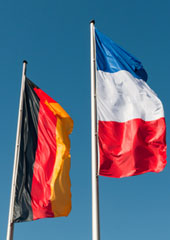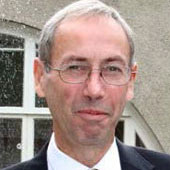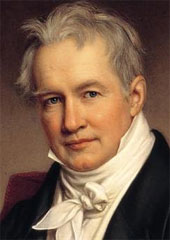The French Revolution and Modern Germany
How did Germany link its own ideas to those emerging from France, North America and South America in the late 18th and 19th centuries?
January 19, 2013

The French Revolution recast German politics — whether by imitation, appropriation or rejection. Events in 1790s France had an immediate effect, prompting popular disturbances and a wave of enthusiasm among German writers, both established and young.
Some went to Paris as “pilgrims of revolution.” But the ensuing terror led to disillusion.
“They have betrayed our ideals and dragged them in the mud,” lamented Caroline Schlegel. Klopstock stopped writing odes to liberty. The radical course of the French Revolution reinforced pride in German “moderation.”
War and occupation driven forward by Napoleon then led both to preemptive reforms and to a spasm of Francophobia among some German intellectuals in the early 19th century.
The French Revolution was transformative. Most obviously, it redrew the map of central Europe and destroyed the Holy Roman Empire. But it also turned Germany into a constitutional laboratory.
That process began in 1806, with the Napoleonic puppet states and the new constitutions granted in Baden and elsewhere. It continued, however unevenly, through the eras of reform and reaction, and through the renewed political unrest of the years after 1815 in Greece, Italy, Belgium, Poland and Germany itself.
Most German rulers found themselves with new subjects after the Napoleonic years and the 1815 settlement. They also had to operate on new political terrain.
They were forced to learn — some were slower learners than others — how to manufacture consent through state building, invented traditions and timely concessions. By 1847, only four of the 39 member states of the German Confederation had no constitution.
Prussian Minister Karl August von Struensee told the French chargé d’affaires in 1799 that the revolution the French had made “from below” would be completed “gradually, from above” in Prussia.
Very gradually, it must be said, for Prussia was one of those four states that still lacked a constitution until after 1848.
Hierarchy, order and faith
That is the view from the top down. But the French Revolution also bequeathed a new political vocabulary of nation, rights, liberty and a new set of political symbols — the tricolor flag and the liberty tree.
The use of this language and these symbols during German popular disturbances after 1815 was part of the French legacy, especially in the Rhineland. So was the cult of Napoleon that persisted across the German lands.
But the French Revolution was also responsible for creating a modern German conservatism that had its own reference points, the “historical” and “organic,” and its own vocabulary — hierarchy, order and faith.
German nationalists appropriated and reworked the new French political vocabulary, sometimes with an anti-French twist — although more so after the Rhine crisis of 1840 than before, and never universally.
One French lesson had a long afterlife. That was the lesson of the Reign of Terror, or “the Terror.” Even in the 1790s, Germans who welcomed the revolution had been drawn more to the Girondins than the Jacobins (Mirabeau was a great favorite). This was consistent with a widespread view shared by some German rulers that through their revolution the French were simply catching up with German enlightened reforms.
The subsequent “excess” and supposed “self-interest” of the Revolution undermined its appeal as a vehicle of reason and virtue. For German liberals, although not for radical democrats, the French Revolution provided the tools with which they forged a reformist but anti-revolutionary message: reform was necessary, because reform denied led to revolution.
The American Revolution had been less bloody and more practical than the French — less “metaphysical,” said one admiring writer. The lessons Germans drew from events across the Atlantic often served as a foil to their reception of the French Revolution.
The United States interested German liberals because of the emphasis placed on constitutionalism, individual rights, religious toleration and the rule of law. In other words, for the same reasons that Britain served as a model, with the added interest that the United States created a federal system.
Perhaps the German Bundestag could be reformed into something resembling the American Congress?
The United States also offered the example of a new state being built from scratch, as the post-1815 German states were in fact being built. Yet, the signature aspect of the American Revolution — “We the People,” popular sovereignty — was largely bracketed out of German liberal, although not radical, discussions.
More than that: despite their sympathy for the American experiment, German liberals largely agreed with German conservatives that U.S. institutions could not simply be “injected” or “transplanted” into Germany.
What was suitable for a rudely vigorous people in a wide-open land without history was not necessarily right for an old society. This revolution could not be transferred from the “free soil” of the Americas to Europe.
Radicals disagreed. These “world-historical events” — the term was much bandied about before Hegel took it up — represented “the seeds of a better future” (I quote from an article in the Politisches Journal of 1815). The great revolt in South America would “perhaps sooner than some would like to think pull the European motherland into its powerful vortex.” Some wanted to speed these world-historical events along.
South America became a site of German radicalism. Hundreds of Germans fought in Bolivar’s legions, others fought in the Uruguayan war of independence and in the two republican uprisings in Southern Brazil.
In the second of these, in 1835, the Germans who fought alongside Garibaldi in the Guerra dos Farragos (the war of the ragamuffins) flew the red-black-gold flag of German radical nationalism.
This was, of course, a displaced radicalism — a physical-force variant of the verbal radicalism practiced by a new German political emigration that stretched from Paris, Brussels and London to the Americas.
Goethe, for his part, pinned an admiring note about Bolivar to the door of his bedchamber and proposed a design for the new Venezuelan national flag based on his theory of primary colors. (The proposal was adopted.)
In the decades from 1770 to 1820, German writers changed the way we think about ethics, the theory of knowledge, religion, law, language, music, art and aesthetics, work and vocation, humans and the natural world, and — not least — history.
And what they wrote had a far-reaching impact. German ideas and German culture went around the globe.
The first part of David Blackbourn’s two-part series, Germany and the Birth of the Modern World, is German Scientists as 18th-Century Globalists.
Takeaways
The French Revolution turned Germany into a constitutional laboratory.
The United States also offered the example of a new state built from scratch to the post-1815 German states.
German Radicals believed the "world-historical events" in South America represented "the seeds of a better future."
From 1770 to 1820, Germans changed the way we think about ethics, knowledge, religion, law, language, music and art.

